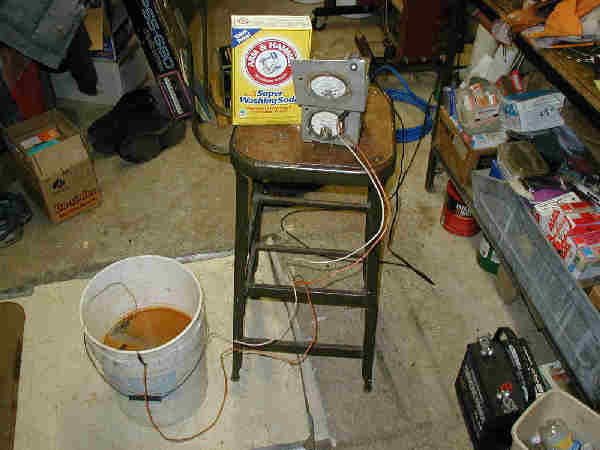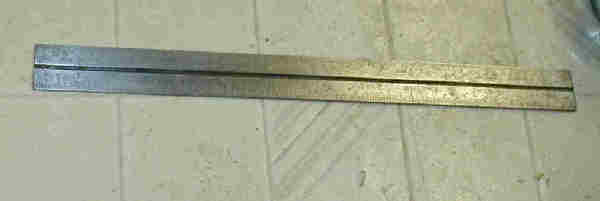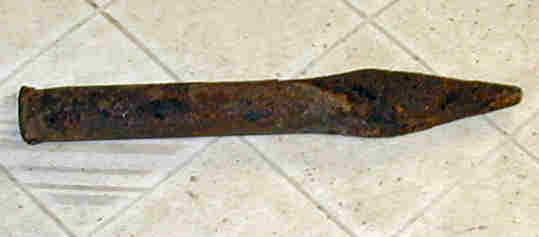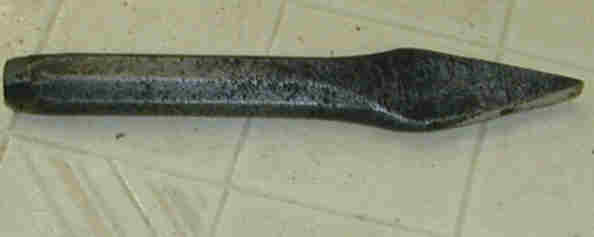
A horse shoers rasp. I only derusted half of it to better show the difference that the process can make.
This is my short page about electrolytic derusting.
I've got some before and after pix and a few notes about the process that may have escaped some readers.
If you don't know what I'm talking about it's a great way to get red rust off of any iron/steel stuff
and it can't hurt the material.
If you search for "electrolytic rust removal", you will get lots of hits. Take a look at some of them
if you want more detail.


A horse shoers rasp. I only derusted half of it to better show the difference that the process can make.

This is the 12" ruler from a combination square that I bought at a flea market for one dollar. The rust was so bad that
I couldn't read ANY numbers. As you can see, it cleaned up nicely. There are finer scales on the backside that I didn't
even know were there before derusting it! Here is a case where I didn't want to use a wire brush.

Here's a "before of a VERY rusty cape chisel, again, from the flea market. I think you are supposed to wire brush the worst
of the rust off before you put the part in the pail, but I didn't and it worked out okay. I have also heard that you should
remove any grease and oil from the part first. I think this is a very good idea.

Here's the same cape chisel after about a day in the pail. I removed and cleaned it off 3 times or so during that period.
This is a case of deep pits. So, after scrubbing with scotch brite, I wire brushed it to work the black stuff out of some
of the pits.

In trying to show the problem with the pitting, I only derusted half of this old Drift. I hope you can see that I sure
did get rid of the red rust. But, of course, the black stuff down in the pits are still very much visible. I even wire
brushed vigorously, but I still couldn't get to the bottom of some of them.
1. You can't put back metal that's already rusted away, so if there's a pit in the part, there will still be a pit in the part when you are done. Some of these pits may be deep enough that its hard to get the loosened black stuff out of them. I used scotch brite to get the black stuff off and it worked well on things that simply were rusty. But things that were badly pitted needed a wire brush. Wire brushing a chisel isn't a problem for me, but wire brushing a 12 inch ruler would ruin the apprearance. So, there's a limit on what you can "bring back to life".
2. Too bad, but this process doesn't work on mill scale. I tried. The scientists say the mill scale is a ferrous oxide that doesn't have an "extra" atom of oxygen to give up in THIS process.
3. The first time I tried this process, a few years ago, I was somewhat dissapointed that I didn't get the orange grunge floating on the top of the water that other people had described. That time I had used a stainless steel anode (the positive plate). This time I used a piece of mild steel and I sure did get the grungie goo on the top.
4. This time, it seemed that the current dropped off considerably after several hours. I noticed that the anode had gotten thickly coated with rusty grunge, something that, I think, didn't happen with the stainless steel anode. When I scraped the stuff off the anode, the cureent went right back up.
5. Repeat after me: Negative Lead to the part, Negative Lead to the part, Negative Lead to the part, Negative Lead to the part, Negative Lead to the part.